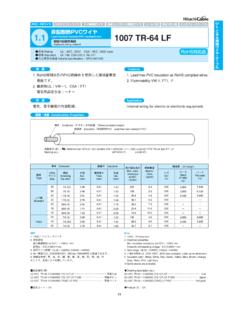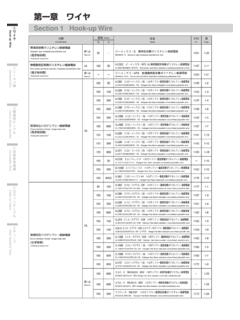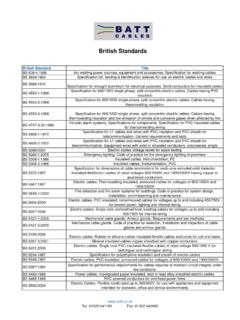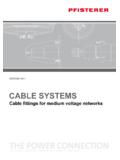Transcription of Resistance Temperature Detectors (RTD)
1 4949 Delemere Ave., Royal Oak, Michigan 48073 Phone (800) 876-4442 Fax (248) 280-099850A96. Sheath Material (See page 14 for other Materials) 4 = 304SS (1650oF)(Std) 0 = 310SS (2100oF) 6 = 316SS (1650oF) I = INCONEL (2150oF) HeadFittingOption-FixedBushing A B FittingOption NPTB ushingOption 1C ConnectionHeadOption-CastIron B TipStyle-RoundTip G ConnectionHeadOption-Aluminum A HeadFittingOption- NPTHexNipple G TipStyle-FlatTip F RH N1 2 3 4 5 6 7 8 9 10 11 12 13 14 Resistance Temperature Detectors (RTD)Style H Connection Head Assembly4.
2 Sheath Operating Temperature2. RTD Element Type Material Resistance Temp. Coefficient A = Platinum(Std) 100 ohms @ 0oC .00385 ohm/ohm/oC B = Platinum 100 ohms @ 0oC .00392 ohm/ohm/oC C = Platinum 500 ohms @ 0oC .00385 ohm/ohm/oC D = Platinum 1000 ohms @ 0oC .00385 ohm/ohm/oC F = Nickel 120 ohms @ 0oC .00672 ohm/ohm/oC G = Copper 10 ohms @ 25oC .00427 ohm/ohm/oC H = NiFe 604 ohms @ 0oC .00519 ohm/ohm/oC3. Tip Style / Element Accy. (See Diagram TS-RTD) .01% .02% .03% .05% .10% .50% Flat Tip: M L K P F(Std) I J Round Tip: H E D A G B C Vented Tip: Q U T W V R S4.
3 Configuration (See Diagram RTD) A = 2 Wire - Single Element D = 4 Wire - Dual Element* B = 3 Wire - Single Element(Std) E = 6 Wire - Dual Element* C = 4 Wire - Single Element Z = Other5. Sheath Operating Temperature A = -200 C to 260 C (500oF)(Std) C = -200 C to 600 C (1200oF) B = -200 C to 400 C (750oF) Z = Other7. Sheath Diameter (Metric sizes also available) G = .125* I = .250* M = .375 H = .188* Q = .313 Z = Other*Not available for all head styles*Quick delivery F 1. Connection Head (See page 19 for other C-Heads) A = Aluminum G = 316 Stainless Steel B = Cast Iron S = 316SS Explosion Proof C = FMCUS Alum.
4 EXP V = Dan D = Poly Black - Chain Y = APEX Aluminum EXP E = FDA Ploy - Latch (Consult Factory for Specialty Web: Email: H Connection Head AssemblyE = FDA Poly - LatchH = FDA Poly - Chain D = Black Poly - ChainF = Nylon HeadB = Iron HeadC = Cast Aluminum EPS = 316 Stainless Steel EPA = AluminumM = Alum. MiniatureQ = Nylon MiniatureR = CanisterV = Dan HeadO = Open Ceramic BlockG = 316 Stainless CONNECTION HEAD OPTIONS11. Fitting Location F (inches from tip) N = No Fitting Location (Std)13. Bend Angle (See Page 49 for more information) N = None(Std) G = 45 Degree Bend S = 90 Degree Bend Z = Other HEAD MOUNTING FITTINGSD iagram HFFixedBushing(Std)FixedHexNippleSingleM aleNPTD oubleMaleNPTFor more Connection Head options go to 9.)
5 Head Mounting Fittings (See Diagram HF) A = Fixed Bushing (No process threads) (Stainless) (Std) P = Pipe Nipple (specify in notes) N = None Z = Special Compression Fitting Connection 1/8 NPT 1/4 NPT 1/2 NPT Hex Nipple Connection 1/4 NPT 1/2 NPT 3/4 NPT Fixed Hex Nipple (Steel) F G H Single Male NPT (Stainless) - - S Fixed Hex Nipple (Stainless) I J K Double Male NPT (Stainless) W X Y 14.
6 Bend Location C (inches from tip, see Diagram BEND page 49) N = No Bend(Std)8. Sheath Length L (Example = 12-1/2 inches) - inches Z = greater than inches (Consult Factory)CONFIGURATION (RTD)Diagram RTDFor a larger selection of RTD Assemblies go to: 12. Special Options (Choose all that apply - See Page 17 for more Options) N = None B = RTD Transmitter* (See page 71) C = Programmable Transmitter* (See page 71) H = High Vibration K = Copper Tip I = SS ID Tag M = MgO Construction P = Electro-etching Q = Ground Screw S = Spring Loaded T = Coated Probe Y = Certificate of Conformance 6 = Tip Sensitive Element Z = Special (Consult Factory)*Not available for all head styles 10.
7 Fittings (See page 18 for more info and other fittings) (Metric fittings also available)N = None (Std) FB = Fixed Bayonet Fitting (.188 and .250 Dia only) Z = Special NPT Fittings 1/8 NPT 1/4 NPT 1/2 NPT SPECIAL Fixed Bushing (Stainless) 1A 1B 1C 1Z Compression (Brass) one time adj. 5A 5B 5C 5Z Compression (Stainless) one time adj. 6A 6B 6C 6Z Compression (Stainless) re-adjustable* 7A 7B 7C 7Z *Teflon gland standard (400oF) for other gland options such as Lava (1200oF) see page 18 Explosion ProofQ = Oversized AluminumNEWSTYLEWeb: Email: principal of the Resistance Temperature detector (RTD) is not nearly as complex as that of a thermocouple.
8 Basically, the principal of operation depends on the fact that the electrical Resistance of metals varies directly with Temperature , and is reproducible to a high degree of accuracy. The curve of Temperature versus Resistance for a given wire material can thus be predicted by employing a constant, known as the Temperature coefficient of Resistance . Useful sensitive elements of RTD S are those which show a Resistance Temperature relationship of acceptable magnitude. Two such metals are Platinum and s are commonly used in sensitive areas requiring much tighter accuracy than thermocouples.
9 But accuracy is dependent on the RTD leadwire configuration. Leadwire error can have a significant effect on accuracy. Adding leadwire between the RTD and control will add additional Resistance to readings. Since Resistance increases with Temperature it is not recommended to use a 2-wire RTD when a high accuracy is configuration is the least accurate RTD configuration. The lead wire Resistance is not compensated for by the transmitter or controller. The increased Resistance will cause Temperature to be higher than the actual configuration is the most commonly used.
10 The added lead wire Resistance is calculated by the control through a third wire. The leadwire Resistance is then subtracted from the loop Resistance and true Resistance is given. Through this method the controller or transmitter compensates the lead wire giving an accurate Temperature display. 4-wire configuration provide slightly better compensation, but are generally found only in laboratory equipment and other areas where high accuracy is required but must be used in conjunction with a 4-wire Temperature Detectors (RTD)Stainless Steel SheathTypical 3-Wire Probe ConstructionCeramicEncapsulatedElementGa p for ExpansionJunction - Copper Leads Tack Welded or Sliver BrazedTeflon or Glass InsulatedStainless Steel SheathTypical High Temperature 3-Wire Probe ConstructionCeramicEncapsulatedElementMg O FilledJunction - Nickel LeadAlumina InsulatorsJunction - Copper LeadsTack Welded or Sliver BrazedTeflon or Glass Insulated Copper LeadsStainless Steel SheathCeramicEncapsulatedElementJunction Junction - Copper LeadsTack Welded or Sliver BrazedTypical 3-Wire







